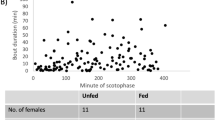Abstract
The diel pattern of pheromone-releasing behavior (calling) of the adult female brown-banded cockroach, Supella longipalpa (F.),was examined. Calling occurs discontinuously throughout most of the scotophase in a 12L: 12D photoperiodic regime. Females exhibited a free-running calling rhythm after transfer to continuous light or dark conditions. Shifts in the temporal pattern of calling following changes in the timing of the photoperiodic cues indicated that “lights-off” is the Zeitgeber. Studies of insects under long- and short-day conditions suggest that, although insects within a population may call synchronously or asynchronously, respectively, the duration of an individual's calling bout is innately limited.
Similar content being viewed by others
References
Adiyodi, K. G., and Adiyodi, R. G. (1974). Control mechanisms in cockroach reproduction.J. Scient. Ind. Res. 33: 343–358.
Aschoff, J. (1979). Circadian rhythms: Influences of internal and external factors on the period measured in constant conditions.Z. Tierpsychol. 49: 225–249.
Baker, T. C., and Cardé, R. T. (1979). Endogenous and exogenous factors affecting periodicities of female calling and male sex pheromone response inGrapholitha molesta (Busck).J. Insect Physiol. 25: 943–950.
Brady, J. (1974). The physiology of insect circadian rhythms.Adv. Insect Physiol. 10: 1–115.
Delisle, J., and McNeil, J. N. (1986). The effect of photoperiod on the calling behavior of virgin females of the true armyworm,Pseudaletia unipuncta (Haw.) (Lepidoptera: Noctuidae).J. Insect Physiol. 32: 199–206.
Dreisig, H. (1976). Phase shifting the circadian rhythms of nocturnal insects by temperature changes.Physiol. Entomol. 1: 123–129.
Dreisig, H., and Nielsen, E. T. (1971). Circadian rhythm of locomotion and its temperature dependence inBlattella germanica.J. Exp. Biol. 54: 187–198.
Hales, R. A., and Breed, M. D. (1983). Female calling and reproductive behavior in the brown-banded cockroach,Supella longipalpa (F.) (Orthoptera: Blattellidae).Ann. Entomol. Soc. Am. 76: 239–241.
Leppla, N. C., Koehler, P. G., and Agee, H. R. (1989). Circadian rhythms of the German cockroach (Dictyoptera: Blattellidae): Locomotion in response to different photoperiods and wave-lengths of light.J. Insect Physiol. 35: 63–66.
Liang, D., and Schal, C. (1990a). Effects of pheromone concentration and photoperiod on the behavioral response sequence to sex pheromone in the male brown-banded cockroach, Supella longipalpa.J. Insect Behav. 3: 211–223.
Liang, D., and Schal, C. (1990b). Circadian rhythmicity and development of the behavioural response to sex pheromone in male brown-banded cockroaches,Supella longipalpa.Physiol. Entomol. 15: 355–361.
Lohmann, M. (1967). Ranges of circadian period length.Experientia 23: 788–790.
Pittendrigh, C. S. (1965). On the mechanism of the entrainment of a ciracdian rhythm by light cycles. In Aschoff, J. (ed.),Circadian Clocks, North-Holland, Amsterdam, pp. 276–297.
Saunders, D. S. (1982).Insect Clocks, 2nd ed., Pergamon Press, New York.
Schal, C., and Bell, W. J. (1985). Calling behavior in female cockroaches (Dictyoptera: Blattaria).J. Kans. Entomol. Soc. 58: 261–268.
Schal, C., and Cardé, R. T. (1986). Effects of temperature and light on calling in the tiger mothHolomelina lamae (Freeman) (Lepidoptera: Arctiidae).Physiol. Entomol. 11: 75–87.
Schal, C., and Smith, A. F. (1990). Neuroendocrine regulation of pheromone production in cock-roaches. In Huber, I., Masler, E. P., and Rao, B. R. (eds.),Cockroaches as Models for Neurobiology: Applications in Biomedical Research, CRC Press, Boca Raton, Fla., Vol. II, pp. 179–200.
Seelinger, G. (1984). Sex-specific activity patterns inPeriplaneta americana and their relation to mate-finding.Z. Tierpsychol. 65: 309–326.
Smith, A. F., and Schal, C. (1990). Corpus allatum control of sex pheromone production and release in the female brown-banded cockroach,Supella longipalpa (F.) (Dictyoptera: Blattellidae).J. Insect Physiol. 36: 251–257.
Turgeon, J., and McNeil, J. (1982). Calling behavior of the armyworm,Pseudaletia unipuncta.Entomol. Exp. Appl. 31: 402–408.
Author information
Authors and Affiliations
Rights and permissions
About this article
Cite this article
Smith, A.F., Schal, C. Circadian calling behavior of the adult female brown-banded cockroach,Supella longipalpa (F.) (Dictyoptera: Blattellidae). J Insect Behav 4, 1–14 (1991). https://doi.org/10.1007/BF01092546
Accepted:
Issue Date:
DOI: https://doi.org/10.1007/BF01092546




